1. Udder Changes
We like to use udder development as a good indicator of how far along a cow is. This measure is usually effective for dairy cattle, whereas beef cattle do not always “make up” an udder much before calving.
Keep in mind a few things:
- Every cow develops differently. The heifer in these first pictures did not make up as much edema as heifers often do, so she is a good average between heifer and cow.
- Cows that have calved before are very different from heifers. You may not see much change in the udder until a few days before to a day after calving.
A note on the photos below. The Jan 1 photo is after little man (her baby) nursed. He was born in the night and when we peeked out the window about 7am, he was curled up sleeping, dry and full. So that is a post-milking photo. 🙂
2. Pins & Ligaments
Many people may ask about “the pins”. First, you need to know what they are! Pins are a part of a cow’s hips. Basically, “hooks” are the FRONT (closer to head of animal) part of the hips and “pins” are the BACK (closer to tail) part of hips.
Okay, so now, why are “pins” important? Well, 12-24 hours before a cow calves, the pins will change in preparation for calving so that a cow can push a 50-100 pound calf out.
There will be a noticeable loosening of the ligaments on each side – BETWEEN the PIN bone and the TAIL bone, the ligaments will soften and become loose and jelly-like (compared to normal muscle tone/normal ligament strength).
Think of there being a rubber band holding the pin bone to the tail bone, on each side. Picture the rubber band tight. Then picture the rubber band relaxing and sagging, so that when the calf comes out that little tiny space, the rubber band can be stretched wide open (and the pin bones along with it) for the calf to come out.
Seeing this change is a good indication your cow is imminently close to calving – like, time to bring her into the barn and check on her every hour or two!
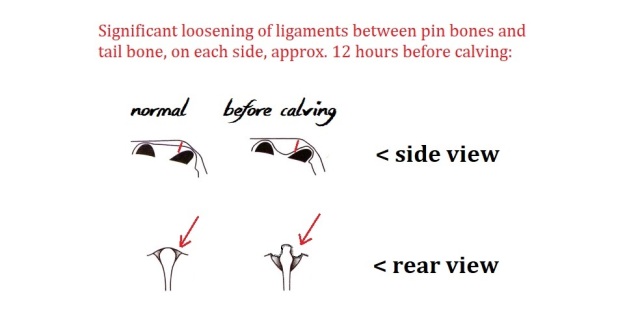
To Measure Pin Ligament Changes: Do not measure a cow by looking at her once. Rather, start to monitor how she looks and then keep tracking change as she gets closer to her calving date. You may see slight softening of the ligaments as she “blooms” in preparation the final month. But the change we’re talking about is the significant change (up to inches in loosening of the ligaments) that indicate imminent calving.
Thin Cow Disclaimer: Pins are NOT a good reference point on thin cows. If a cow is really thin, she may always look like her ligaments are loose, when it’s really a lack of fat/muscle/bloom.
Photo example of changes in pin ligaments:
Same photo, with red circles emphasizing area in question:

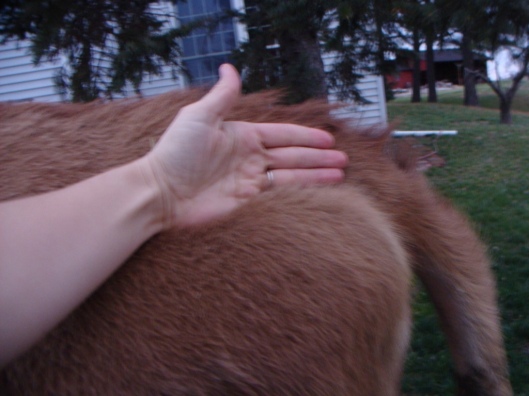
Do I find pins a good indicator for beginners to know when their cow is soon to calve? Not necessarily. I find that so many cows are different, I mean recently I saw a cow that looked like Rosalind post-calving (Jan 1 photo) and she waited several more days to calve! Instead, I like to include “pin development” on my list of things to watch (check out the full list on the Calving Preparation page).
This last calving was my first time photographing and marking development of the pins. The photos are more difficult to take versus seeing the cow live, but they can give you an idea of how even on Dec 29, she had not developed a huge amount in the pins. That look was where she had been for almost two months, and I attribute it to the fact that she was a tad on the thin side when she arrived early November to our home.
Another udder example:
March of 2015 calving – First photos taken of heifer about 1 month from calving:
Next photos taken 3 days before due date:
Photos taken night of due date:
Photos at birth (about 7 hours later):
A third example:
Five weeks before due date:

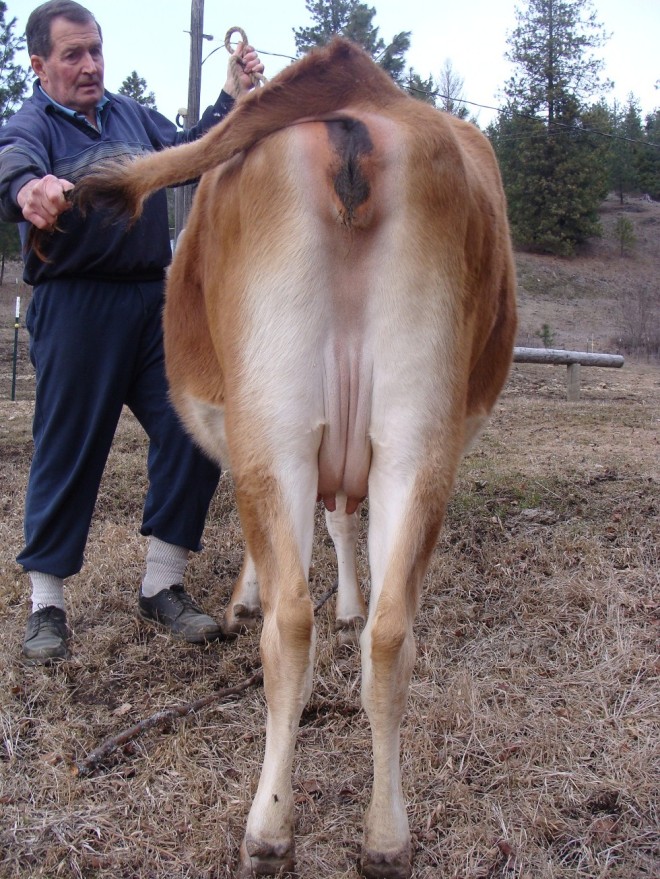
Three weeks before due date:
One week before due date – she’s not gonna make it any longer!
Heifer calf born unassisted about 10:30 pm (earlier photos (above) were taken around 4:30 PM)
Example of a mature dairy cow:
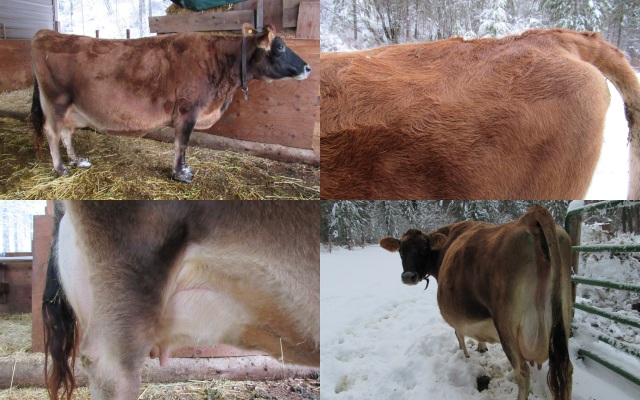
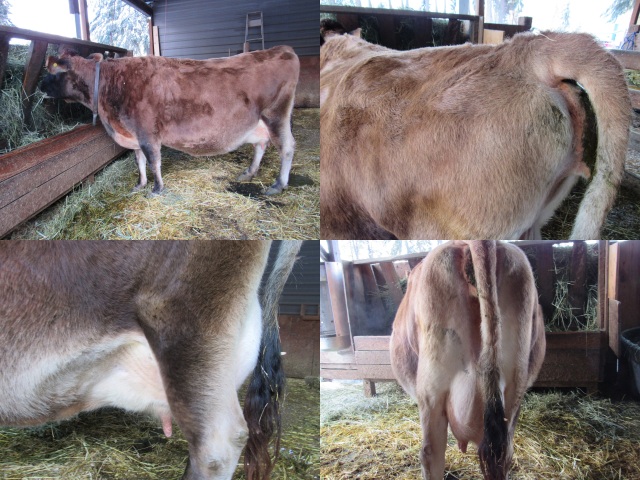
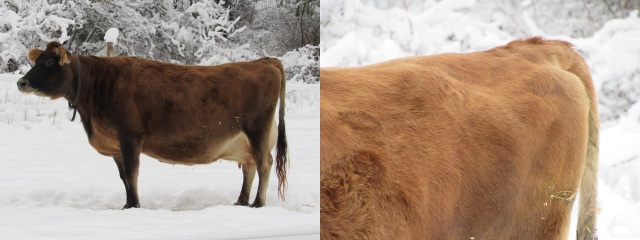
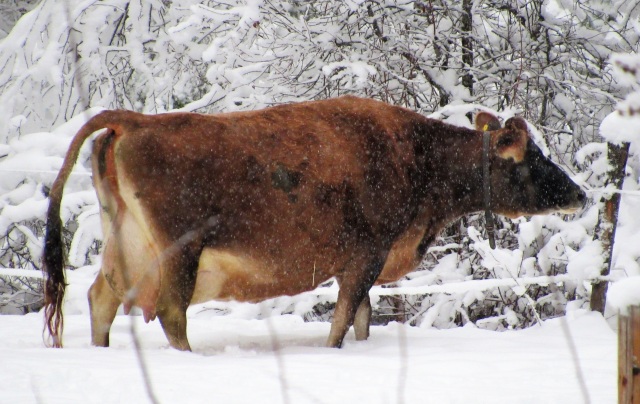

A happy ending … heifer calves! 😀

A few parting notes:
- Heifers tend to calve early, but any cow or heifer can calve several days in one direction or another of her due date. I’ve seen calves born two weeks early or over two weeks late with guaranteed breeding dates (meaning not just that a bull got them on a different heat).
- Be sure you have the right calving date! It’s easy enough to get dates mixed up. Keep records and check a gestation calendar to double check your math. You can find one on this page: Breeding Your Cow
- The “Medicine Box” area of this website has many sections relevant to calving, particularly: Calving Preparation and Medicine Box
- Focus on what is important for this calving. For example, if you have a heifer, you may want to read up on and be prepared for pulling a calf, as a heifer may need more help than a mature cow. If your cow has had multiple lactations or is a high producer, read up on milk fever and ketosis.
- Don’t forget to prepare for a baby, as well. Sometimes, we get so excited for our cow to calve, we forget about preparing for the calf! (And what to have on hand in case the calf is sick!)
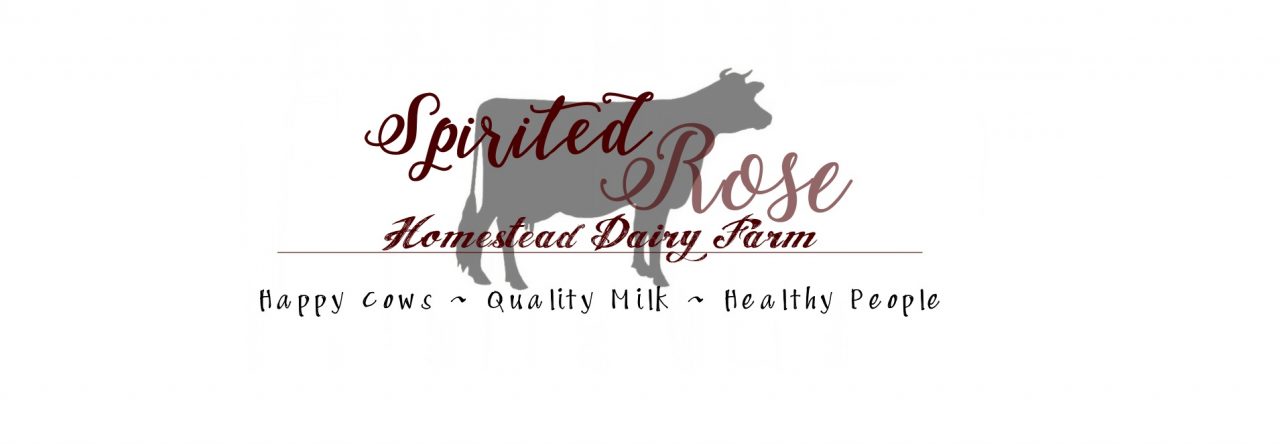


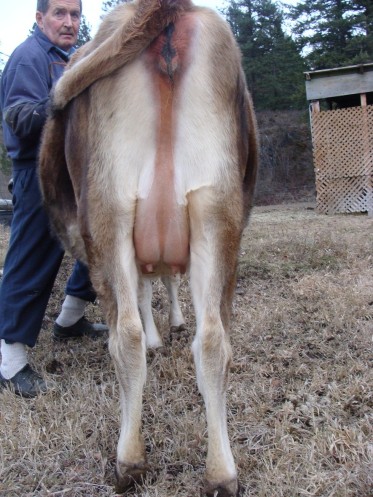





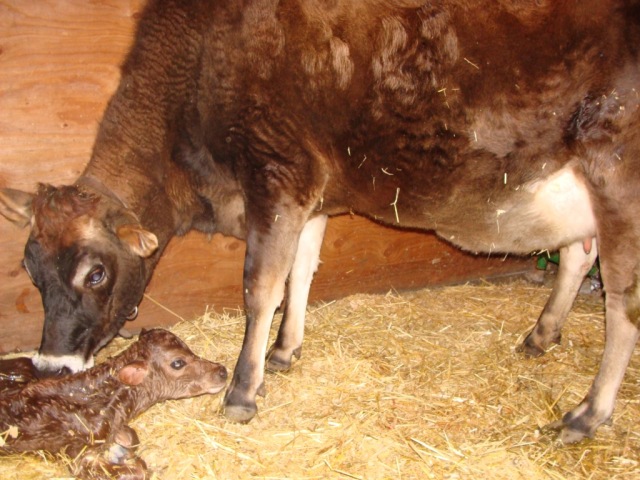

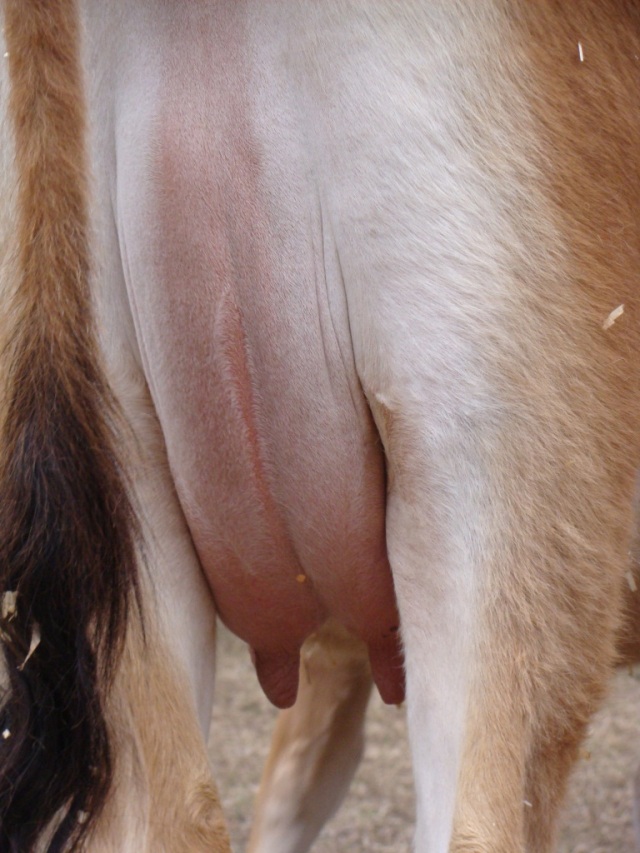
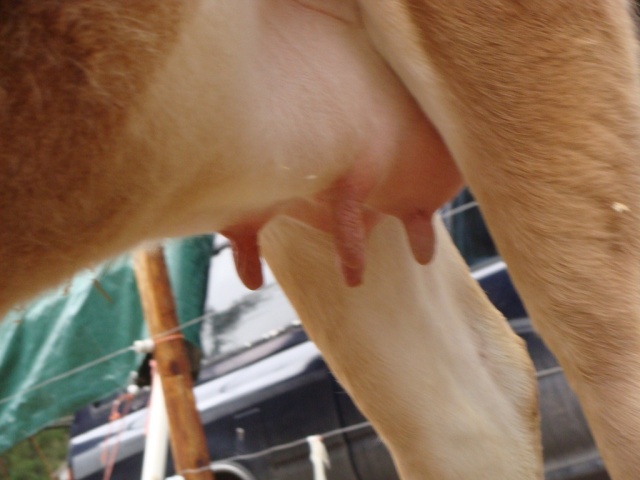

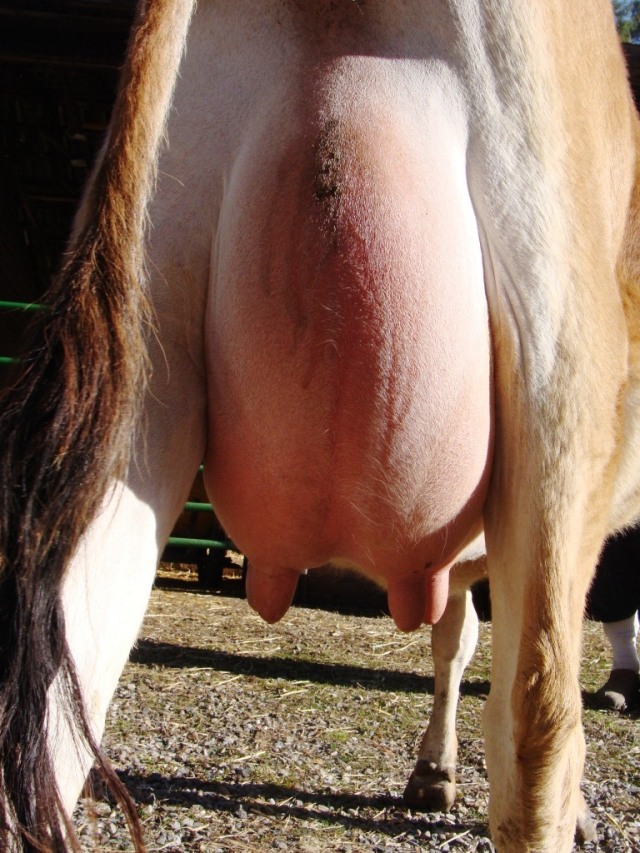


These are great photos, thanks for sharing!
I’m at instructor at the University of Guelph (Canada) and I was wondering if I could share these pictures in one of our class lectures?
LikeLike
Hi Lauren,
Yes, feel free to use the photos for your class. Thank you for asking.
LikeLike
When looking at replacement heifers, can a high tail-set on a beef heifer/cow possibly predict the need to pull calves from this animal?
LikeLike
Some say yes, that a high tail-set can correlate to undesirable angles at calving. Set of the rump can also affect calving ease – extreme high pins or an extreme slump of the rump (poor thurl bone angle). None of them are huge or insurmountable issues, just things to avoid or try to breed out in future generations.
LikeLike
Hello, I was wondering if I could email you a picture of my Jersey and get your opinion? She was AI’d back on February 26th and again in May because we didn’t think it was successful the 1st time. She is huge, and vulva swollen so we have had her pinned up for a few weeks with slow progress. She’s so huge we are worried there could be twins.
LikeLike
Hi, I have a heifer that I had bred to a jersey bull on Aug 23rd. 21 days later no heat so I thought, yay she is pregnant, 21 days later she came into heat. (ugh) She is a very obvious heat cow no mistaking it, very vocal. Anyways so I thought ugh ok so I had the AI guy come out as I could not locate a bull the 2nd time around. 21 days later no heat. Perfect went all winter with no signs of heat so thats great. She suppose to be due on the 9th of September anyways I started noticing her bag developing didn’t think to much as I figured she’s a heifer maybe she is just preparing but I checked on her yesterday we are now at May 13th and boy she sure looks like she is bagging up. Is it possible for her to have been bred the first time around even though she was bulling afterwards? First due date May 26th only 2 weeks away second due date Sept 9th 3-1/2 months away. Thank you for any input you may have.
LikeLike
If she’s due on the 26th, she should have a pretty substantial udder by now. If you send me an email through our contact page, then I can send you my email address and you can send me a photo of her. I can give you an idea of whether the May due date is likely or not.
LikeLike
Hi! I have a similar question to the one above and would be grateful for your advice/opinion. First time heifer, AI so due in 6 days (283 days). So far she is showing no signs at all of springing. She is producing milk as our other cow’s calf has been suckling from her (we didn’t realize but are planning two colostrum feeds for the new calf). Does springing always start 2 weeks before, or can it happen very soon and suddenly before calving? Many thanks and fab site, Camilla
LikeLike
Camilla – My first guess would be that she is not pregnant – did you confirm pregnancy in this heifer? If she is pregnant, then my guess is that she is not showing normal edema because she was brought into milk early. Be sure to purchase colostrum replacer for the calf, just in case the cow does not have sufficient colostrum at the time of calving. (The cow should still develop colostrum for the calf, but in cases where a cow is pre-milked, a replacer should be on hand in case the cow does not have colostrum.
LikeLike
Hi, thanks so much for your reply. She was confirmed pregnant about 3 months after the AI, then again by the vet approximately 2 months ago. We have the colostrum replacer ready to go and will try and get both feeds down the calf (if it arrives). I read a post yesterday about someone’s cow/heifer being 3 weeks overdue and then delivering successfully so I was wondering whether the lack of springing in the vulva means she is still some way off, or if they can just spring a day or so before calving? As you say maybe she won’t spring at all normally because she’s already been suckled…?
LikeLike
Yes, cows can be 3 weeks overdue. The vulva may not change much, some animals do not dilate very much, which is not great but usually they get dilated enough to calve. Have plans to help pull the calf just in case. It’s ok if the vulva has not changed, but there should be udder changes of some kind. If she does not have udder changes and she does not calve and she goes 3 weeks overdue and nothing happens, I would guess the calf died in-utero and a vet may have to help remove the calf and give the cow hormones. Hopefully that’s not the case and she’s just a slow developer. Feel free to contact me via email if you would like to send pictures of her. https://spiritedrose.wordpress.com/contact-us/
LikeLike
What if the volva ain’t springing,,,it was but stopped a couple weeks ago,,,,now it looks tight and pinched,,,,she is in labor,,,
First time heafer,,,4 years old,,
Thanks Patti
LikeLike
Hi,we have a red Angus Jersey cross who was bred sometime in June to early July. I am not sure when,because she was with the bulls until she was 15 months. We had to slaughter them on the 10 th of July. She has developed an udder,but not really large ,also has some springing of the vulva. She doesnt seem to have much discharge though. Is there a way to work out when she would be due? This is our first time. Not sure how the estrus cycles work. Thanks
LikeLike
If the bulls were butchered on July 10th, with a normal gestation of 283 days, her last possible due date (not taking into account the possibility of going overdue) would be April 18th. There’s no way to figure out an exact due date with bulls, but then even with AI, there’s the possibility of calving early or late. So I would watch for key signs she’s due to calve and check on her frequently as she gets close. Watch for the signs of imminent calving in hopes of catching the birth (if she runs to the far end of the pen to calve in secret, excess edema building up in the rear udder or belly floor, shiny waxy looking teats, spraying milk from teats, contractions, tail sticking out, etc.)
LikeLike
Hi
Thanks for the very informative post.
I have two Jersey heifers that are both close to calving. In the past we have only had beef breeds so this is my first dairy calving experience.
Is it essential that a Jersey heifer is milked or can we just leave all the milk for the calf?
I have heard that they can suffer from mastitis if they are not milked.
LikeLike
Correct, you should always start out milking a Jersey. The calf in the first days will only take a gallon of milk per day or so. If she turns out to be a low producing cow, then you may be able to allow the calf to take all her milk. If you do leave the calf on 24/7, watch the calf closely for milk scours – because they may end up gorging on milk.
LikeLike
Hiya!
My heifer is due any day now and I have a question about when to milk after the calf is born? Do I wait a couple hours to make sure I don’t take too much colostrum?
Also, she is spraying colostrum off an on for about 3 days now. Do I need to go buy some, or do you think there is still plenty for the calf? thanks a bunch
LikeLike
We milk within an hour or so of birth, hand milking colostrum into a bottle to feed the calf. That way we can guarantee when and how much colostrum the calf drank. Getting colostrum in the first few hours is your best guarantee the calf gets quality colostrum. From there, we milk at our next regular milking (usually within 6-8 hours). We try to get about 3 bottles worth of colostrum into the calf in the first 24 hours, spaced out at birth, around 12 hours, and around 24 hours old.
If she is just leaking or squirting a little colostrum, the quality should still be sufficient at birth. If she is spraying significantly, you may want to buy colostrum supplement to add to the first colostrum feedings for the calf.
LikeLike
Thanks so much for your quick reply! Very helpful!
LikeLike
Hello, quick question. Is blood normal in discharge of a Jersey dairy cow? Not thick but definitely mucusie blood. I do believe she is breed as she has a Jersey bull living with her. Thoughts?
LikeLike
Blood is normal a few days after a heat cycle (whether or not she conceived). Blood is also normal during calving and for two or three weeks afterwards, in small amounts, as her body cleans. If you do not know for sure she is pregnant, I would recommend doing a pregnancy test (milk – http://www.animalprofiling.com or blood – http://www.biotracking.com ). If she is open, I would assume the blood was from a normal heat cycle. If she is pregnant, I would be concerned she is aborting and if she’s new to you or you’re new to cows, you may want to have a vet check her out and test her blood with an “abortion panel” which can check to see if she has any diseases that cause abortion.
LikeLike
Good morning, can you identify for me on a photo where I should be looking for loosening of ligaments by the tail bone on a Jersey cow? Thank you,
LikeLike
I bought a cow a couple months ago from a dairy. I was told she was due mid to late June. Its July now and nothing. Her udder shows no change. She does have mucus discharge almost every day and last week had a bit of fluid dripping when she would lie down. Is it possible she won’t develope her udder until labor starts? She is a dairy breed (guernsey).
LikeLike
Dairy breeds usually always make up an udder before calving. If she was bull-bred, then her breeding date could be off. If it were my cow, I would draw blood and send it to http://www.biotracking.com (they have a map that can get you the info for your closest lab). The test will tell you if she is pregnant. From there, it’s a waiting game to see when she calves – at this point there would be no reliable way to tell her exact due date. If the test came back open, then you would know she’s open and wouldn’t keep waiting for a calf and could give hormone shots, etc. to get her to come back into heat.
LikeLike
Hi! I have the same questions as the rest of you! It’s my first having a calf, very
nervous! We bought her knowing she would have a baby April 24 if the AI took.
If not, 3 weeks from now (she was put in with a bull). We have her pinned up just
in case it is today. How long should I wait to put her back with the others if she is
not due for another 3 weeks? I have been checking out all the signs of birthing, she
has a few signs, but not much is happening. Just want to make sure our little Annie
is ok!
LikeLike
Is she showing signs of being due very soon? If not, she probably took to a later breeding date. Cows should not be kept in a pen so small that their movement is limited, but they also should not be out on the open range so close to calving. If you can keep her nearby but in an area she can move around, that would be best. Preferably somewhere you can easily see her.
If she is a dairy cow, her “signs” of calving should be very obvious – her udder should be large and uncomfortable and tight, her vulva should be large and sloppy, she may be dripping milk or acting weird. There are lots of signs that should make it obvious – if you’re not seeing much, then sounds like you have some time. Feel free to email me some pictures, I can take a look at her and see if there’s anything further I could notice.
LikeLike
My heifer should be due any time. she is discharging for a few weeks now and starting to bag up .we put her in a pen as the fields are wooded and dont want to have to hunt for . will this hinder her timing for calving ? as she seems to cry for her friends
LikeLike
Being in a smaller pen is a good idea. If you could bring in a companion to be nearby, that would be helpful, but otherwise she’ll just have to live through it. Hope she calves well.
LikeLike
Thanks for this post. Very informative.
LikeLike
I bought a bred beef cow back in December of 2016, said it was 5×7 at the time… I’ve been watching!! For ever.. lol, when a cow was said to be bred for 7 months I was told it could be longer than that. I know it’s an impossible question but in this case how long could it have been bred for, is there a chance she is eight months along when I got her? The bag is starting to take shape, there is discharge and the whole pin bone thing is beyond me. Any thoughts of how much longer I may have? Thank you!!
LikeLike
Yes, with beef cows bred to a bull, their due dates can vary widely! Unless the breeding was AI or the farmer took the cow on X day to be bred to the bull and no other day, then you really don’t know the due date. To complicate things further, beef cows don’t develop an udder in the same way that milk cows do.
If you think she’s just starting to make up an udder, you’re probably 2 to 4 weeks away. The discharge is very normal and very good to see – means she’s progressing in a healthy way!
Feel the ligament between her pin bones (the back hip bones) and her tail head/spine – right now it’s probably fairly firm. If you want to learn how it changes, feel it a few times and if one day you come out and the pin ligaments are loose like jello, she’s probably very close. If you miss the calving, you should still be able to feel the pins be loose for a little while after calving.
Waiting is the hardest part of calving!! 🙂
LikeLike
Is it normal for the calf to be extremely active inside? It’s like she has a pure. Red ninja in there….! Lol
LikeLike
Some are very active! 🙂 I’d take that to be a good sign!
LikeLike
How much longer. Last week she had a weird slimmy discharge. That stopped. For a week now she has been pawing and rocking when she lays down. And just being different.
LikeLike
Don’t know exactly due date on mine. We got her already breed. Was told late Nov. She had a slimmy discharge last week but that stopped. She is pawing the ground and rocking when she lays down. Acting weird so now udder is filling up. Nervous she is our first. How much longer.
LikeLike
Discharge can show up on and off for several weeks before calving, it is an indicator she’s doing everything right.
Pawing and rocking are likely because she is very uncomfortable. The last month or so, the calf grows the most and the cow becomes very uncomfortable.
Udder filling up happens in the last couple of weeks before calving. Very close to calving the udder usually changes a lot (grows about double in size in one day), also the teats may go from wrinkled to full or even start spraying milk.
When she’s calving, you may hear her make a lot of noise, have contractions, lift her tail and not put it back down, see discharge with blood-tainted fluid. She may head to the far end of her pen, as far away from people/home as possible (she’s trying to calve in a “safe” quiet location).
Hopefully you’ll head out soon and see a calf on the ground. If you see her pushing or see feet but nothing progresses over the next 30 minutes or so, you should call a cattle friend or vet to come help assess her.
LikeLike
Thanks I’m just worried. Don’t want to lose them. It’s our first time.
LikeLike
Thanks
LikeLike
You guys are awesome my cow is killing me that I do not now when calve
LikeLike
Yes, waiting for a cow to calve can be quite difficult!
LikeLike
Thank you! This gives me a better timeline. Excellent photos for us to reference. Your cows and people were great sports!
LikeLike
Love, love your website! So much good information. Thank you for taking the time and effort to do this 🙂
LikeLike
Thank you for visiting. 🙂
LikeLike
Thank you! I’ve been looking for something like this for a while. My dairy heifer is so different from my beef cows/heifers!
LikeLike
I love this. Everything is explained so very well. Thank you! So helpful!
LikeLike
When will the udder begins to grow in a heifer….. At which month of pregnancy
LikeLike
The answer varies by animal and breed. Usually you start to see some changes around 7 months and real growth between 8-9 months. In beef heifers, you may see little to no udder changes before calving.
LikeLike